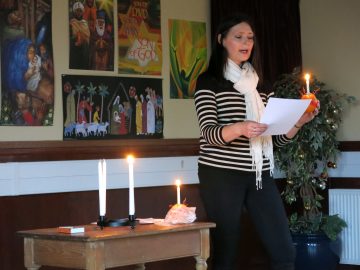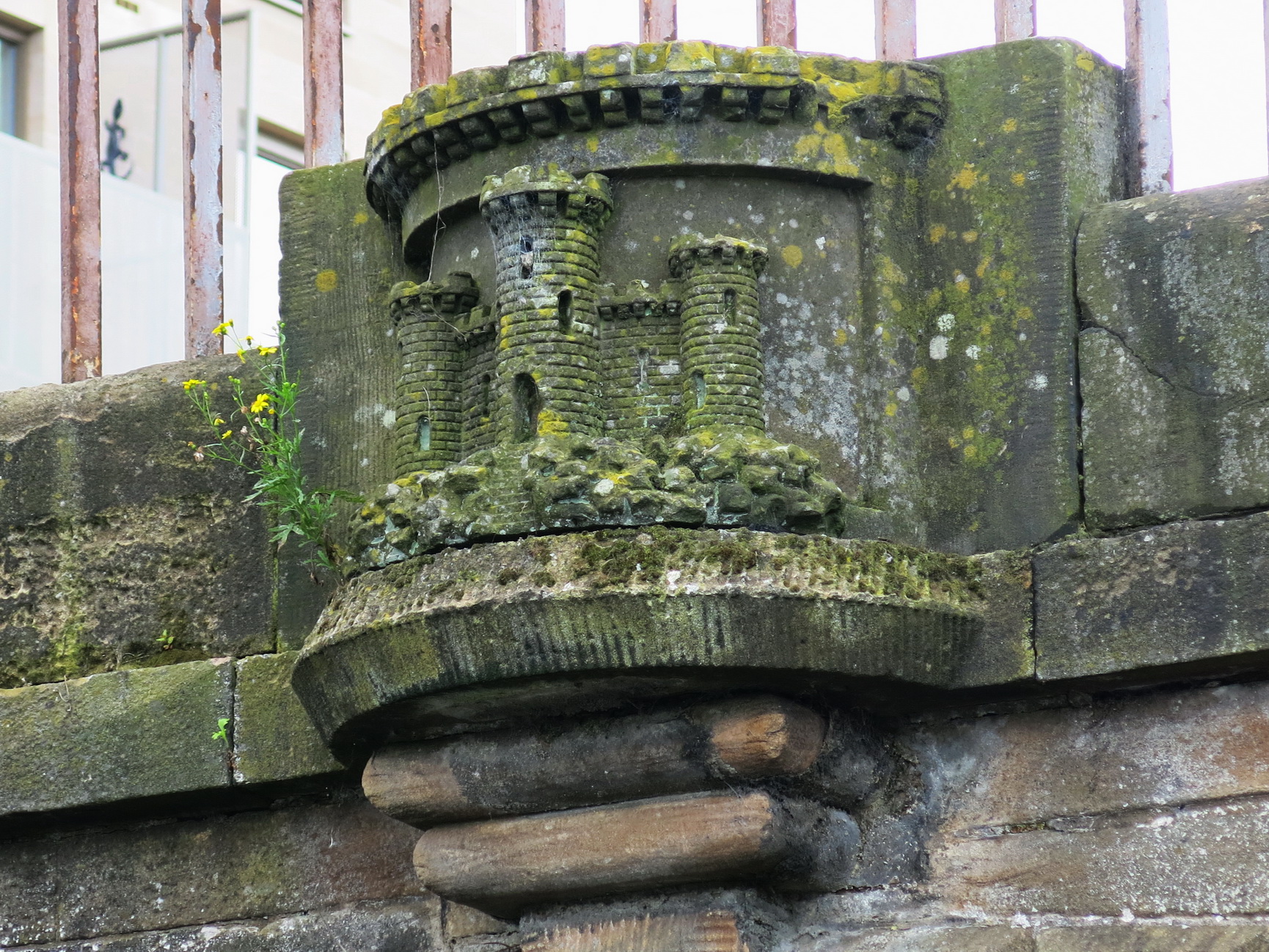Recent meetings
Gymanfa Ganu 2020
Sunday 1 March 2020
Thirty members and friends responded to the invitation to come and sing hymns at our mini Gymanfa Ganu, and thoroughly enjoyed themselves. Huw and Janet Thomas again performed their ‘double act’, with Janet introducing the items and Huw presiding on the piano, once he’d reminisced about the Easter Gymanfa tradition among Llanelli Baptist Churches!
This year the focus was on hymns that hadn’t been sung during the previous two years. Though this removed many favourite tunes one might have expected to hear, such as Rachie and Calon Lân, the choice didn’t disappoint, and even included Trewen and Bryn Calfaria, these having previously slipped through the net.
As always, we learned new things about the creative people responsible for “the web of Welsh hymn-writing”, and this year we were introduced to the unusual numbering system used in the Society’s (Welsh Presbyterian) hymn books, with different numbers for the words and the tunes. So we sang one of Elfed’s hymns twice to different tunes – Huw playing a third tune that also fitted – and both (thankfully short) hymns to another tune. Harmony was achieved when we had sung twelve hymns and twelve tunes!
We also learned that “Love divine, all loves excelling” had been sung at Huw and Janet’s wedding but, while she remembered the words, he remembered the tune! This was of course Blaenwern, a tune by William Penfro Rowlands that dates from the Welsh revival of 1904–05, the name referring to the farm in Pembrokeshire where the composer convalesced in his youth. We sang Charles Wesley’s words in English, but this was the only exception, and we were even able to sing Stuart Townend’s “How deep the Father’s love for us” in a Welsh translation – it went remarkably well.
Jennifer Welsher made an appearance to thank everyone, and to make a plea for members to bring to the AGM their ideas for celebrating the Society’s Centenary year, and a most enjoyable occasion was suitably concluded around the tea trolley, which gave an opportunity to welcome some new and younger faces. Thank you to everyone who came, and to all the organisers, but especially to Huw and Janet.
St David’s Day dinner
Saturday 29 February 2020
This was the year that the wall came down! The Mortonhall Golf Club had to remove a partition to make room for our 50 members and friends, and the spaciousness was very welcome after the crush at the bar. Part of the reason for the larger numbers was that we were delighted to welcome family supporters from all over the country – as our President, David Hughes, reminded us at the start of the proceedings, during 2019 we had lost three Society stalwarts, Arthur Phillips, Stephanie Ledger and Keith Welsher.
After Grace (said by Margaret Brandie) and an excellent meal, David Hughes introduced our Gwr Gwadd, Professor Wayne Powell, who is Principal and Chief Executive of Scotland’s Rural College (SRUC). We learned of Wayne’s early days in the mining community at Abercraf, of his studies in Aberystwyth (where he played a lot of rugby!), and his first career teaching PE and maths in Reading (plus playing for London Welsh), before a switch of discipline to work with the Welsh Plant Breeding Station back in Aberystwyth.
Thereafter Wayne’s new career took off, with “memories of a great time” in 1980s Edinburgh, followed by a seminal year in Delaware, at the cutting edge of molecular biology and experiencing the open culture of US science at DuPont’s Wilmington facility. His moves thereafter gave him time in Cambridge and Adelaide, experience in managing change both personally and in institutions, and an enduring sense of the importance of food and of the great privilege of being able to use science to deliver practical benefits for agriculture and for rural economies throughout the world.
In his vote of thanks, Colin Mumford asked how any of us could match a life experience that included responsibility for a School of Wine (known enviously as the ‘School of the Good Life’) and offered mischievous suggestions as how improvements to grasses might aid our players!
David Hughes then thanked everyone for their contribution to the evening, and presented flowers to Jennifer Welsher, our Secretary and dinner organiser. Finally, as always, Jim Hughes and his friends led us in singing some favourite hymns and songs before “Mae hen wlad fy nhadau” concluded the evening.
Mae oren y Cristingl
Sunday 8 December 2019
Our annual Carol Service took a different turn this year, when we each took an orange and a kit of parts and tried to assemble a Christingle like the ones on the table and that Margaret is holding! The custom can be traced back to a Moravian church minister in Germany in 1747, and was introduced to the UK in 1968 as a fund-raiser for The Children’s Society, but this seems to have been a first for EWS!
Naturally there was a Welsh “Cân y Cristingl” by Glyndwr Williams (read the words at this link), sung to the tune The Holly and the Ivy. Add to that five readings and six other carols and Christmas hymns, and we definitely earned our tea! The singing went well, though we missed a number of our regulars.
The service was devised, organised and led by Margaret Brandie, and our thanks go both to her and to the whole Brandie family who were involved in different ways. Thanks also to Huw Thomas for leading from the piano and to Jennifer Welsher, who organised the refreshments.
Afterwards your webmaster also enjoyed that evening’s edition of Dechrau Canu Dechrau Canmol, which was based at St Fagans National History Museum and looked at how Christmas in Wales has changed over the centuries. Cor Caerdydd sang well, despite the evidently cold chapel! For the next month you can enjoy the programme at this link.
The explanation for the Christingle symbol is
- the orange is round like the world
- the candle stands tall and straight and gives light in the dark like the love of God
- the red ribbon goes all around the ‘world’ and is a symbol of the blood Jesus shed when he died for us
- the four sticks point in all directions and symbolise North, South, East and West – they also represent the four seasons
- the fruit represents the fruits of the earth, nurtured by the sunshine and the rain
Scotland in stone
Saturday 7 September 2019

We met up at the Barony Castle Hotel and after refreshments we wandered through the woods to view the 3D map of Scotland made by a small group of Poles out of stone. Thereafter we adjourned to the Green Tree hotel in Peebles and enjoyed a hearty meal.
Thanks to Lilian for organising the trip and to Jean for contributing her local knowledge and organising the lunch.
Ed: You’ll find more about this most interesting work of art at this link.
Union Canal walk
Saturday 20 July 2019
All technology was new once … amidst the celebrations on 20 July of a Moon walk 50 years before, our walk along the Union Canal reminded us that 200 years ago the Union Canal was being built!
When we met at Edinburgh Quay, we might have assumed that Lochrin Basin was its starting point. However, Jean Bareham, our guide – ably assisted by young Benji – first took us into the middle of new developments at Old Fountainbridge, where she pointed out where canal wharves had once extended to Earl Grey Street. We saw evidence of the former meat markets in the area and, later in our walk, the lift bridge that had once carried the Fountainbridge traffic over the canal.
Our travels took us only a short way along the canal – and it was, as promised, easy walking along the towpath – but we learned a lot about the history of the area, and were encouraged by the current redevelopment of two adjacent major sites to allow people and businesses to coexist in an area that had once housed a brewery and rubber factory.
The view certainly wasn’t all of industry and development – within a short time we were in countryside, and enjoying a goodly collection of wild flowers and plants and a pair of swans with their family of eight cygnets. The canal is a wild life corridor into the city, and home to a number of endangered species – Hywel’s hat nearly became one!
Our guided tour ended in the tranquil surroundings of Polwarth Church gardens, but we were then guided to Boroughmuir Rugby Club for a very pleasant drink on the terrace in the sunshine that had been with us most of the afternoon, and onwards (for those needing more solid sustenance) to the Kilted Pig.
Thanks to Lilian, whose idea the walk was, to Jean for leading us so informatively, and to Hywel for leading us to places of refreshment.






















